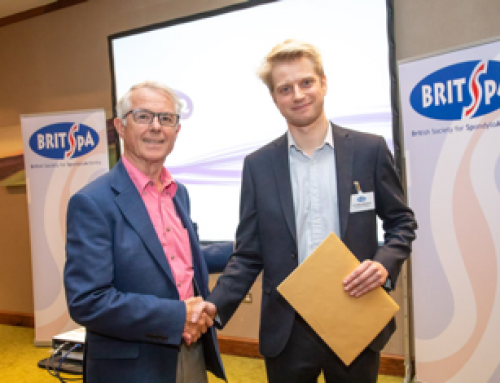This year BRITSpA run its second abstract competition, with twelve submissions considered and four delegates asked to present. The winner of the certificate and cheque for £500 was Tim Bray (London) who gave an excellent presentation of his work entitled “A tiny bit of white on MRI”- objective definitions of oedema and fat metaplasia in spondyloarthritis”.
Tim has been working with Margaret Hall-Craggs and other collaborators at UCL on exploring mechanisms to reduce poor reproducibility between observers and different centres on interpreting definitions of MRI lesions of inflammation and structural change in SpA. They have used a novel quantitative fat fraction (FF) mapping MRI to objectively quantify both active inflammation (bone marrow oedema) and structural changes (fat metaplasia) and have shown that FF mapping can accurately separate bone marrow oedema and fat metaplasia from normal marrow. This method allows objective identification of inflammation rather than relying on inconsistent visual scoring (‘a tiny bit of white on 2 consecutive slices2), which is currently standard practice and as such it has potential significant implications for its use in the clinical setting. Read the full abstract here.

Sarah Sacks from the Nuffield Department of Orthopaedics at Oxford presented an abstract entitled “Incidence of Total Hip and Knee Replacement in Ankylosing Spondylitis Patients in England and Wales: a population-based cohort study” describing the occurrence of total hip (THR) and knee replacement (TKR) within a large primary care cohort of 9,766 AS patients from the United Kingdom (UK) Clinical Practice Research Datalink (CPRD). She showed that 2.6% and 1.8% of patients received THR and TKR respectively in the ten years following diagnosis suggesting an increased need for THR over TKR for patients with AS. Read the full abstract here

Joanna Shim from the Epidemiology Group at the University of Aberdeen presented the abstract entitled “Does commencement of biologic therapy improve work outcomes in patients with axial spondyloarthritis (axSpA)? Results from British Society for Rheumatology Register (BSRBR-AS)”. She concluded that in patients with axSpA, commencement of biologics is associated with an improvement in presenteeism and work productivity, but no significant improvement in absenteeism nor overall activity impairment. Read the full abstract here.
.

Sizheng Zhao from Aintree University Hospital, Liverpool presented on behalf of her collaborators the abstract entitled “When should lateral dual energy x-ray absorptiometry be used to measure spine bone mineral density in axial spondyloarthritis patients: a cross-sectional study”. In their work, Dr Zhao explored how AP-BMD changes with axSpA symptom duration, and whether optimum assessment should include lateral spine DEXA. They concluded that after 13 years follow up, AP-BMD was higher with increasing symptom duration which likely reflects accrual of pathological new bone. AP-DEXA can be used to assess BMD during the first decade of symptom duration, after which lateral DEXA should be considered particularly in those with known syndesmophytes. Read the full abstract here



